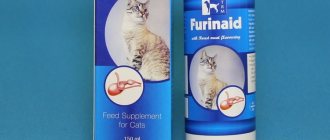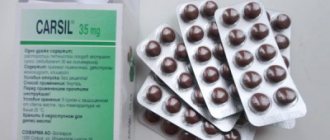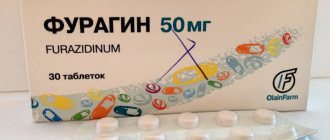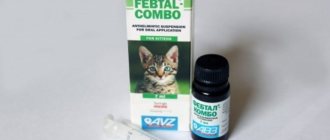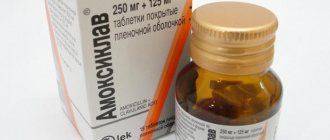Description of the drug
"Vermox" is a drug intended for the treatment of ascariasis.
The drug is not a veterinary medicine and therefore cats can only be treated with it in exceptional cases. There is no need to use it to prevent diseases. There is no need to risk your pet's health unnecessarily.
The main active ingredient is mebendazone. Its job is to suppress the production of tubulin in parasite cells. Also, the drug reduces the synthesis and eliminates accumulated reserves of adenosine triphosphoric acid, which leaves helminth cells without energy and causes their death.
Anthelmintic medications, including mebendazone as the main component, have a number of advantages: when passing through the gastrointestinal tract, they are absorbed extremely slowly, only about 10%. So the drug, in almost unchanged form, enters the feces, killing parasites.
Vermox is produced in tablet form. Externally, they are white in color and have a double-sided deep diametric notch dividing the tablet into two halves. Packaging is done in blisters of 6 pieces. Each blister comes in a separate cardboard box, complete with instructions for use. The date of release of the drug and the period before which it must be used are indicated on the packaging.
Medicine that has expired, has been soiled, or contains tablets that have changed color cannot be used to treat a cat (and neither can a person).
Characteristics of the drug
This is the name of the medicine for the treatment of ascariasis. Let’s immediately make a reservation that you can give it to cats only as a last resort, when there are no alternatives at all! There are many purely veterinary drugs created specifically for animals, the effect of which on cats has long been studied and described. It’s not worth taking risks unless absolutely necessary!
The active substance is mebendazone. The mechanism of action is based on disruption of the synthesis of tubulin in helminth cells. In addition, the drug prevents the formation and destroys existing ATP reserves, which deprives parasite cells of energy and leads to their death. Antihelminthic drugs based on mebendazone have enough advantages: they are very slowly (within five to ten hours) absorbed from the gastrointestinal tract, about 10% of the total dose enters the blood (on average 5-7%). More than 90% of the drug remains unchanged in the feces, so helminths have a hard time.
The medicine is available in tablet form. The pills look white, each of them is divided into two equal halves by a deep score. Packaged in blisters made of food grade plastic and aluminum foil. Packed in cardboard boxes indicating the name, release date, batch and expiration date. One package contains one blister with six tablets. It is strictly prohibited to give expired medication, as well as pills that have changed their color, with foreign impurities, or moistened, to a cat (and to people too).
Indications for use
The drug "Vermox" is especially effective in treating cats for pinworms. But it also works well against infestations by flatworms (tapeworms) and nematodes.
The effect of the medicine is excellent in the treatment of mixed helminth infections, but mono-infection is also successfully treated. "Vermox" is used for :
- ascariasis (infection with roundworms);
- enterobiasis (pinworm infection);
- taeniasis (infestation with pork tapeworm);
- trichocephalosis (whipworm infection).
Often, after the treatment is completed, veterinarians no longer give Vermox to a cat or dog; they recommend taking laxatives to remove dead worms from the animal’s body.
It should be noted that the main substance of the drug tends to accumulate in adipose tissue. Therefore, in obese cats, frequent use of Vermox can cause accumulation of the drug in the body and lead to an overdose.
Analogs
Complete analogues (synonyms) of the drug are:
Of the veterinary medications, Milbemax is now especially popular.
The variety of modern drugs against helminth infections in veterinary medicine is amazing. There are hundreds of items, and the pharmaceutical industry is constantly producing new ones! But sometimes it happens (in remote settlements where there are no veterinary pharmacies) that you have to use the range of ordinary, “human” hospitals. There you can find the drug Vermox, originally intended to destroy worms in the human body.
Application procedure
The medicine must be taken orally. The cat needs to be given an eighth of the tablet. In order not to make a mistake with the dosage, it is recommended to grind the tablet to a powder and dilute it in 8 ml of water. Mix everything thoroughly. The cat is given 1 ml of the resulting solution, which is drawn up with a syringe (without a needle) and poured into the animal’s mouth. The prepared solution of the drug must be stored in the refrigerator. It is suitable for use only during the day.
It should be noted that the drug tastes bitter, so you need to be prepared that you will have to forcefully give your cat Vermox for worms.
Vermox is given to the pet twice a day, 30 minutes before feeding. Duration of treatment – 3 days. Repeat the course a month later. But it is advisable to purchase veterinary medications for these purposes. They are available in almost every specialized pharmacy.
Note:
The given dosage of Vermox for cats is calculated for the average size of the animal. But to be on the safe side, it is better to consult a specialist to prescribe the correct amount of medication. The dose of the drug may vary depending on the weight and gender of the pet. It is prohibited to independently treat a cat with Vermox. Vermox is contraindicated for kittens; it is fatal for them. If during treatment, something unusual is noted in the animal’s behavior, you should immediately stop taking the drug and consult a doctor.
Contraindications and overdose
Due to the fact that the drug "Vermox" was not created for the treatment of animals, it has a certain list of restrictions for use. It should not be given :
- kittens under 1 year of age;
- cats that, in addition to helminthiasis, also suffer from some other infection;
- weak and exhausted animals;
- during pregnancy and lactation;
- in an immunodeficient state;
- for liver and kidney diseases;
- with ulcerative lesions of the intestine;
- individual hypersensitivity to the components of the product or an allergic reaction.
It is not recommended to give Vermox to excited and angry animals. Make sure the dosage is correct so as not to overdose. This can cause coma and death of the pet.
Signs of an overdose in a cat may include::
- the appearance of vomiting with foam;
- diarrhea;
- thirst;
- frequent urination;
- lethargy.
If even minor symptoms occur that indicate an overdose of the drug in an animal, stop taking the medication and immediately consult a veterinarian.
Side Effects
Usually the correct dose of the drug does not cause adverse side effects in a cat or dog. If Vermox is poorly tolerated, then the first thing that the animal will develop is intense vomiting. As soon as this symptom appears, you must immediately contact a veterinarian. Before transporting the animal to the clinic, it is recommended to arrange for the pet to perform independent gastric lavage. When intolerance manifests itself in a mild form, the cat or dog is bothered by loose stools, which can be expressed in both moderate and intense forms. If stool disorder is observed in a mild form, then it is recommended to use symptomatic correction of the condition.
Side effects of Vermox in animals
Important!
If you notice signs that your pet is not tolerating treatment well, you must immediately stop taking the drug. You should consult your veterinarian regarding the possibility of using the medication in the future.
Side effects
Usually, with the correct dosage of the Vermox drug, side effects do not occur. However, the main symptom of drug intolerance is severe vomiting. If such a symptom appears, it is necessary to perform a gastric lavage on the cat and, as soon as possible, take the animal to a veterinary clinic.
Sometimes, with a mild degree of intolerance to the drug, diarrhea appears (of varying severity). For mild diarrhea, symptomatic treatment is carried out. If severe, stop taking the drug immediately. The question of further treatment is decided by the veterinarian. Usually the medicine is replaced with one specially designed for animals.
Important! Vermox is used to treat cats only when absolutely necessary, carefully, under the supervision of a doctor, so as not to harm the animal. You cannot replace “Vermox” with a similar drug, “Dekaris”. It is life-threatening for cats.
Short description:
The main active ingredient of this drug is mebendazone. It has a toxic effect on many types of helminths, causing their degeneration and death. Vermox is primarily used to treat helminth infestations in humans, but can also be used in animals. It is effective in the treatment of arichocephalosis, ascariasis, hookworm disease, strongyloidiasis, taeniasis, as well as mixed helminthic infestations. This medicine is excreted mainly in feces, 5-10% of the drug is neutralized in the liver.
Reviews about “Vermox (tablets) for dogs and cats”:
Our family became acquainted with the most powerful remedy - tableted Vermox - after a summer stay on the hacienda. We chose it taking into account its versatility.
First, helminths were detected in Barsik, then, after carefully studying Murka’s “tests,” they realized that the cat had also picked up parasites. Our constant contact with animals required joint treatment of the whole family.
For general treatment and prevention, the veterinarian recommended Vermox. The dosage for sapiens was clear, but for animals they resorted to weighing. Previously, Barsik and Murka underwent an examination, which confirmed that the team was healthy.
The specialist assured that a single dose of Vermox will be enough for everyone. Homo sapiens washed down the tablets with plain water. The leopard drug was crushed and added to water sweetened with sugar. Murka was administered the solution with a pipette, opening his mouth.
The veterinarian was right - one procedure was enough for everyone. There was no need to take Vermox again. A very effective, radical remedy. Let me remind you once again that all those being treated must have healthy kidneys and liver.
As a preventive measure, we give Vermox to the cat once a year, after we bring him from the dacha. If you have children, then this is a must. Because if your pet is suddenly diagnosed with a parasite, then your whole family will be using Vermox. The dosage depends on the weight of the animal, 1/4 tablet per dose is enough for a cat, a dog doesn’t need anything, but it will kill a hamster. The best thing is that the dosage and duration of taking Vermox should be prescribed by a veterinarian. It is most convenient to administer to an animal with a disposable syringe (without a needle) by injecting it into the mouth, after diluting the tablet in warm water. Or you can push the pill. Place the cat in a lying position on your knees, first spray regular water from a syringe into the mouth, at the moment when the animal makes a swallowing movement, send part of the tablet, slightly guiding it with your index finger. We push the finger into the mouth behind the fangs in the area of the animal’s “molars.” It won't bite that way.
If there is an animal in the house, then Vermox must be present in your first aid kit. God saves man, who save himself.
Due to the fact that Vermox is a drug for treating people, it is given to a dog or cat in the absence of alternative options. In this case, it is necessary to strictly calculate the dosage and coordinate it with the veterinarian. If it is impossible to seek veterinary help, then it is necessary to choose medications produced for dogs or cats. Vermox for animals is less safe and effective than specific medications. It has a good effect not only on roundworms, but on a large number of their species, which allows it to be used effectively for mixed infestations, which are often found in domestic pets.
Vermox for dogs and cats
The dosage of Vermox for cats, as well as for dogs, is very important. If it is calculated correctly, then the effectiveness of the drug is very high. The medicine affects not only mature helminths, but also their larval form and even eggs. By acting on parasites, the medicine causes paralysis of smooth muscle fibers, which leads to helminths detaching from the intestinal lining of the cat or dog. In addition to the above, the drug inhibits the absorption reactions of nutrients, which provokes the death of worms. Vermox dissolves the shell of parasite eggs, and inhibits the development of larvae and prevents their transformation into mature worms capable of reproduction.
What deworming tablets are suitable for small children?
A good anti-worm medicine for children should effectively fight parasites and have low toxicity. This combination is not uncommon today. Pharmaceutical preparations have been developed that are suitable for children under 1 year of age. Treatment of worms in a child should begin only after a comprehensive diagnosis, when the type of parasite, population size, and stage of development of the infection are known. To safely get rid of helminths, combinations of medications are used.
How to treat helminthic diseases in children
How to treat a child for worms? Today, doctors practice an integrated approach to the treatment of helminthiasis. The following medications are used:
Echinococcus and bovine tapeworm can only be gotten rid of surgically.
An important stage in the treatment of helminthic infestations is the intake of sorbents. What should I give my child? The safest sorbent is Smecta. This is a natural product, aluminum silicate with magnesium. The doctor selects the dosage based on the patient’s age. You should not drink sorbents uncontrollably; this can provoke an imbalance of microelements, hypovitaminosis, constipation, and exacerbation of gastritis. Treatment of worms in children is carried out under strict medical supervision.
What are the types of antihelminthic drugs?
Which deworming tablets for children are better to choose? To answer this question, you need to know exactly which parasites have entered the body.
Anthelmintics for adults and children are divided into the following types:
Medicines can be available in the form of tablets or suspensions. It is more convenient to use anthelmintic drugs in the form of a suspension for children under three years of age. This is also taken into account by the doctor when prescribing treatment.
Will traditional methods of treatment for worms help?
Often parents try to cure the baby with the help of folk remedies, drinking decoctions of tansy, wormwood, pumpkin seeds, and doing enemas. These methods rarely give positive results. The love for traditional medicine is justified by the reluctance to poison a child with chemistry. Worms cling to the intestinal walls with sharp hooks, discs, plates, and cannot be mechanically washed out with an enema. The antiparasitic effect (if any) of plant materials is not enough to kill a large number of helminths. Some herbs (tansy), if prepared incorrectly, can cause much more harm to a young body than a chemical tablet. Anthelmintic drugs are now safe for children.
Deworming medications can have different effects on parasites. Some paralyze the muscles. Immobilized worms are excreted in the feces. Other drugs inhibit metabolic processes and energy synthesis, causing the death of parasites. For a child, it is preferable to use the first. When parasites die, they release toxins that cause allergies and adversely affect the nervous system. Paralytic drugs only immobilize the worms, the negative effect of toxic substances on the body of a small patient is minimized.
Pumpkin seeds
What deworming remedies are suitable for young children?
It is difficult to find deworming products for children under 1 year of age. Most drugs cannot be used for up to 2-3 years due to relatively high toxicity. In infants, parasites are removed with the help of Pirantel, this is the best remedy for worms. The dosage is prescribed by the doctor; self-medication is prohibited. The active ingredient "Pyrantel" is poorly absorbed in the intestines and does not enter the bloodstream, the toxic effect on the liver is minimal.
You can remove worms from a child over two years old with the help of Mebendazole and Albendazole. Levamisole is used for children over three years of age.
"Mebendazole"
The anti-worm medicine “Mebendazole” is a highly effective drug. With its help you can cure:
The active component of Mebendazole disrupts the absorption of glucose by parasites and inhibits the synthesis of energy molecules. This leads to the death of helminths. The drug for worms is well tolerated by children. Sometimes side effects may occur - abdominal pain, diarrhea, urticaria, fever.
"Albendazole"
Another relatively harmless anthelmintic drug is Albendazole. The active substance of the drug for children suppresses metabolism in helminth cells, causing death. Albendazole has a wide range of action and is effective against the following parasites:
While taking the drug, the baby may experience headaches, digestive disorders, abdominal pain, and urticaria.
Dosages for children of different ages (from 2 years) are selected by the attending physician. The duration of the course of therapy depends on the type and depth of invasion.
"Levamisole"
Previously, Levamisole was considered only an anthelmintic and was used to treat ascariasis in children over three years of age. Recent studies have shown that the drug is a good immune stimulant. Levamisole enhances weak immune reactions and weakens strong ones. This property is used in the treatment of helminth infections by combining Levamisole with various anthelmintic agents. The drug can be given to children only as prescribed by a doctor.
Side effects of antihelminthic drugs
Can children's deworming pills have side effects? Absolutely all medications have side effects. For children, therapeutic doses are specially selected that reduce the likelihood of unwanted reactions of the body to zero.
Anti-worm medications in children can have the following side effects:
Effective deworming tablets for children are gentle, and adverse reactions rarely develop. If unwanted symptoms appear, you should stop taking it and consult your doctor. Symptoms of intoxication (nausea, vomiting, diarrhea) are often the norm for the first days of anthelmintic.
When not to take antihelminthics
Each individual drug for helminths has its own set of contraindications, they are prescribed in the instructions for use. Children should not take anthelmintic in the following cases:
The components of the drugs are absorbed in the intestines, enter the general bloodstream, then are transformed in the liver and excreted in the urine by the kidneys. If liver or kidney function is impaired, substances will be retained in the body. This may lead to undesirable consequences.
Tablets for the prevention of helminthiasis
When you need preventive medication for worms:
The following medications are suitable for children against worms: Pirantel, Albendazole, Levamisole as an immune stimulant. A specialist will tell you what is best to give to your child. For prevention, a single dose of the drug is usually sufficient. The best way to prevent it is personal hygiene. It is necessary to ensure that children wash their hands before eating, after walking, going to the toilet, contacting animals, and not biting their nails.
Finding a safe deworming remedy for children today is not difficult. Responsible parents should have basic knowledge about methods of infection and methods of treating parasitic diseases. Then the child will be reliably protected from infections.
In childhood, the appearance of worms is a common problem. Children have more contact with contaminated things. Parasitic microorganisms cause a lot of inconvenience and interfere with the normal functioning of the child’s body. If you don't deal with them, you can get a number of complications. Deworming tablets for children can help cope with this problem.
When should children be given anti-parasite pills?
Before you start treatment with anti-worm tablets, you should familiarize yourself with the main symptoms of the presence of parasites in the body. There is more than one type of parasitic microorganisms, and each of them manifests itself differently. However, there are general symptoms of the disease:
- Nausea, abnormal stool. The child develops constipation or diarrhea and bloating.
- I have a stomachache. Painful sensations arise suddenly and disappear in a short time. There is a bitterness in the mouth. Appetite disappears or increases.
- I often feel dizzy and have headaches.
- The occurrence of an allergic reaction in the form of a runny nose, cough, rash. The skin or mucous membranes may turn yellow.
- Sleep is disturbed. The baby sleeps restlessly and often wakes up. At night you can hear the grinding of teeth.
- Periodically, the child suffers from itching in the anus.
- The baby gets tired quickly. His muscles hurt and his lymph nodes are enlarged.
These are not specific signs. For this reason, treatment against parasites is prescribed if 5-6 symptoms from the listed list appear. Before you start taking medications, you should undergo an examination. To do this, a blood test, stool test, and scraping from the anus are taken.
Important! Doctors do not always detect the presence of helminth eggs through examination. Therefore, they prescribe deworming tablets if certain symptoms appear.
Parents should especially monitor preschoolers who attend kindergartens. This is due to the fact that at this age doctors often detect the presence of worms. If you start treating the problem in time, you can easily get rid of it. The main thing is to choose the right tool.
Rules for the use of anti-helminth drugs
Doctors advise leaning towards the medicine that fights a specific type of parasite. Initially, it is worth identifying what type of helminths have settled in the child’s body. Special tests can help with this. After them, the doctor will prescribe a specific drug.
Important! All anti-helminth medications have a toxic effect. For this reason, it is recommended not to self-medicate, but to follow the advice of a doctor.
In addition, you should follow these rules:
- Anti-worming tablets will not cause harm if the patient adheres to the correct dosage.
- The dose described in the instructions may not be suitable in a particular case. Therefore, it must be prescribed by a doctor. For example, the dosage of Vermox is often increased for better treatment.
- To completely get rid of worms, a comprehensive course is used. In this case, the doctor may prescribe several types of medications at once.
- It is worth considering all contraindications of anti-worm medications.
How to get rid of parasites in a child?
When worms are detected in a child, all family members should be treated. This is necessary so that the baby does not become infected with parasites again. If you have animals, then it is worth giving them a special means for prevention that will destroy helminths. After all, pets are the main carriers of parasitic microorganisms.
How to get rid of worms in a child? There is a whole list of drugs that are prescribed taking into account age category, weight, and severity of the disease. Below is a list of means used to destroy helminths in children. This list starts with the safest drug and ends with broad-spectrum medications.
Piperazine
For children, this remedy is offered in the form of a suspension. This is an inexpensive drug with a narrow spectrum of action. It paralyzes the muscles of roundworms and pinworms, but does not destroy them. As a result, the function of the muscular and nervous systems of parasitic microorganisms is disrupted.
Piperazine has a negative effect on adult worms, but it does not kill eggs or larvae. After consuming the drug, the parasites become paralyzed, so there will be no release of toxic substances, which can be observed when they are destroyed. In this case, the child’s body will not be poisoned by the remains of worms. Their paralyzed bodies will be expelled during defecation.
Piperazine is the least toxic drug. If worms have just appeared and the disease is not advanced, then it is ideal for a child.
Important! If a severe infection has occurred, then Piperazine may not be enough. To be sure of the effectiveness of this remedy in a particular case, you should consult a doctor.
The drug has some side effects:
- nausea;
- headache;
- diarrhea;
- painful sensations in the abdomen.
If a person has kidney failure, then after taking the medicine there is a risk of blurred vision, muscle weakness, and hallucinations.
Pirantel
Pyrantel is intended for children over 6 months of age. There are such analogues of the product:
- Nemocid;
- Kombantrin;
- Helminthox.
Pyrantel is one of the best remedies that help children get rid of worms. This medicine kills parasites in ascariasis, hookworm, enterobiasis, and necatoriasis. If a child is affected by roundworms or pinworms, then it is enough to take the drug once. After this, it is worth repeating the reception after 2-3 weeks.
Important! During treatment, it is worth ironing the baby’s underwear and making sure that he adheres to the rules of hygiene.
This medicine can cause the following side effects:
- pain in the abdominal area;
- loss of appetite;
- sleep disturbance;
- vomiting and nausea;
- headache;
- the appearance of a rash on the skin, itching;
- dizziness.
The product should not be used if there are kidney problems. Pyrantel is recommended for use in children under 2–3 years of age. Before one year, you should be careful, since medicine is prohibited for a baby who is less than six months old. For older children, it is better to use other drugs.
Mebendazole
The drug is intended for children over 2 years of age. On pharmacy shelves you can find the following analogues:
- Vermox;
- Mebex;
- Thermox and others.
Mebendazole is a broad-spectrum drug. Therefore, it is used when the body is affected by parasites of various types. This is a strong remedy, so you should be careful when using it. After taking it, the child may:
- liver function is impaired;
- stomach ache;
- vomit.
If large doses were taken, then the following side effects should be expected:
- vomiting;
- dizziness;
- diarrhea;
- increase in body temperature;
- rash and itching on the skin;
- hair fragility;
- anemia.
Children under 2 years of age, as well as those who suffer from ulcerative colitis, should not take this remedy. It is better to use this medicine for older children, after about 8 years of age.
Albendazole
The drug can be taken by children from 2 years of age. There are such analogues:
- Nemozol;
- Gelmodol;
- Aldazole and other drugs.
The medicine is considered a broad-spectrum agent, so it can cope with helminths of various types.
This is the strongest drug that is used to fight worms. But it is worth remembering that it can provoke a number of side effects:
- feeling of dryness in the mouth, nausea, vomiting;
- stomatitis, hepatitis;
- diarrhea or constipation;
- pain in the abdominal area, sleep disturbances, cramps;
- pain or dizziness, decreased vision;
- the appearance of hallucinations, fever;
- skin diseases, itching.
Important! This drug should be used carefully, after consulting with your doctor.
Instructions for use
The canine dose of the medication is 22 mg of the active ingredient per kilogram of the animal’s body weight. This means that the dosage per 10 kg dog will be 220 mg. This is a single dose. It is recommended to give the medicine to your pet twice a day, 30 minutes before meals. Vermox can be given to a dog by mixing it with minced meat or dissolving it in water as a suspension. A good way is to wrap the entire tablet in a small amount of minced meat and form a small ball that the dog can swallow without chewing.
Reviews
One day I went with my cat to visit relatives in the village. There I was cleaning the tray as usual and suddenly noticed worms in it. I didn’t want to wait for treatment, nor did I want to interrupt the trip, but there were no veterinary pharmacies or pet stores nearby. Relatives had Vermox tablets in their medicine cabinet. I called our veterinarian and explained the situation. He told how to make a suspension for a cat from this medicine. I did everything and treated my pet according to the doctor’s recommendations. When we returned, we went to the clinic for examination and were happy to find out that everything was fine.
I once had the opportunity to use Vermox to treat my dog. He managed to deceive Gray by wrapping the tablet in minced meat. There were no particular side effects, only a slight loosening of the stool, which quickly passed as soon as the treatment was completed. But I didn’t use this medication anymore. The veterinarian said that for your pets it is better to use those tablets that are created specifically for them. This is not only more effective, but also safer.
Vermox is an anthelmintic agent. The active ingredient of the drug is mebendazole. Mebendazole reduces glycogen reserves, prevents glucose utilization, inhibits ATP synthesis, and disrupts the formation of the protein tubulin, which is necessary for the construction of the body and vital activity of helminths.
90% of the drug combines with proteins in the blood and accumulates in the liver, fat cells, and helminths. The drug is excreted unchanged in the feces (90%). Part of mebendazole that has managed to be absorbed by the kidneys (5-10%).
After taking the product, veterinarians recommend giving a laxative, since Vermox itself does not cause a laxative effect. When accumulating a dose greater than the therapeutic one, side effects may occur.
Available in the form of tablets containing 100 mg mebendazone, in a blister - 6 tablets. The tablets are white and sometimes slightly yellowish in color.
The drug is effective against helminth infections caused by:
- Gnathostoma spinigerum (gnathostomiasis).
- Capillaria hepatica, philippiensis, aerophila (capillariasis).
- Echinococcus multilocularis (alveococcosis).
- Echinococcus granulosus (echinococcosis).
- Taenia solium (taeniasis).
- Trichinella spiralis (trichinosis).
- Trichocephalus trichiurus (trichocephalosis).
- Strongyloides stercoralis, procyonis, fuelleborni, myopotami (strongyloidiasis).
- Ancylostoma duodenale, dubini (hookworm).
- Ascaris lumbricoides (ascariasis).
- Enterobius sp (enterobiasis).
Can it be given to dogs?
Vermox is a drug made to treat helminthiases in humans. Accordingly, when developing this product, we were guided by the anatomical and physiological characteristics of the human body. Human clinical trials have been conducted for safety and efficacy.
Based on this, Vermox can of course be used by our smaller brothers, but only in situations where it is not possible to buy veterinary anthelmintic drugs. If side effects occur, you must immediately stop taking the drug and give the dog an enterosorbent (activated carbon, Tzamax, Enterosgel).
It is also possible to take Vermox if treatment with veterinary drugs is ineffective. Here, the therapeutic effect provided is given priority over possible side effects. It should be remembered that the drug is used exclusively for the treatment of helminthiases. If you need to choose a preventive remedy, then take a veterinary anthelmintic.
Situations that have an absolute contraindication to taking Vermox in dogs:
- Dogs under 6 months old.
- Pregnant and lactating. Mebendazole crosses the placental barrier and has a teratogenic effect on the fetus. Vermox accumulates in the milk of a nursing dog, causing a toxic effect on puppies.
- Severely malnourished dogs.
- Patients with an infectious disease.
- Dogs with liver and kidney problems. The liver is an organ that performs more than 20 important functions, including the neutralization of drugs (detoxification). In case of liver and kidney diseases, large doses of the drug accumulate, which is fraught with serious side effects, including coma and death.
If a pregnant cat has worms
global $ads_google; //data-ad-slot=”2475549904″ $ads_google = empty($ads_google) ? false : true; ?> if ($ads_google == false) {?> $ads_google = true; ?> } ?>
If a cat is pregnant, the owner will clearly be concerned about the health of the expectant mother and her offspring. For this purpose, preventive measures are carried out three weeks before mating, treating both the groom, if necessary, and the bride. However, if the pussy is preparing to become a mother and has managed to catch helminths, then you need to check with the veterinarian what treatment is appropriate to prescribe based on the test results. There are anthelmintic drugs that have no contraindications for pregnant cats, but there are instructions for taking medications regarding the period. Some medications for cat worms are indicated for the initial stage of pregnancy, and some can be taken in the last weeks.
Instructions for use of Mebendazole
Regardless of the form of release of the pharmaceutical product, each package of Mebendazole is accompanied by instructions for use, which indicate contraindications to the drug, possible side effects, dosage and symptoms of overdose. Therefore, before you start taking the described medication, you should read the instructions.
This medication is prescribed orally, once or twice a day, during or after meals. For enterobiasis, the dosage of the anthelmintic drug is 0.1 g, which should be taken at a time with a small amount of water.
If the risk of re-infection with worms is increased, then take the medication again after 2-4 weeks in the same dosage. For the treatment of ascariasis, it is recommended to take 100 mg tablets twice a day for 3 days.
Adults who have been diagnosed with taeniasis should take 0.2 g in the morning and before bed for 72 hours. To cure helminthosis from the group of nematodes, adults are prescribed 0.2-0.4 g three times a day for the first 3 days, and from the 4th to the 10th - 0.4-0.5 g in the morning , at lunchtime and in the evening.
If a disease has been identified that was caused by the larvae of the tapeworm Echinococcus, then the patient should take an anthelmintic medicine twice a day, 0.5 g for the first three days, and for the next 3 days in the same dosage, but three times a day.
Scope
Vermox is a human drug that can sometimes be given to a dog or cat. But for this it is necessary to carefully calculate all dosages and coordinate them with a veterinarian. To remove worms on your own, it is recommended that animals be given only specialized veterinary medications.
Why is Vermox prescribed for animals in some cases?
Usually, this only happens when, for some reason, it is not possible to purchase a specific veterinary drug. As such, there are no cases when giving Vermox to cats and dogs is preferable to a veterinary drug. Veterinary drugs are safer for animals and are also more effective against worms than those developed for humans.
Vermox works against several types of parasites, but only against roundworms. When infected with tapeworms, it is recommended to choose other drugs. However, the spectrum of action of this remedy includes many types of roundworms, and therefore it is indicated for multi-infestations that often occur in animals.
Reception scheme
This medicine should be given to a dog or cat strictly following certain dosages:
- For dogs, the dosage is 22 mg of the active substance of the drug per 1 kg of the pet’s body weight;
- For cats, the dosage is different - one tablet is crushed into powder and filled with 8 ml of water, then 1 ml of this suspension is given to the pet.
For dogs, the medicine is given twice a day half an hour before meals (the dose indicated above is not divided into two doses, but is taken twice). To avoid problems with feeding the medicine, the tablets can be mixed with minced meat (a small amount), hidden in a piece of sausage, etc. It is important to ensure that the animal does not chew the tablet, as it is bitter and there is a high probability that saliva will flow from the dog’s mouth , and the tablet will not enter the stomach.
Giving medicine to a cat is easier, since in a liquid state it can be poured onto the root of the animal’s tongue directly from a syringe. The medicine is given twice a day half an hour before meals. Instructions for taking the medicine for cats suggest a course lasting three days.
Since this drug is not intended for animals, there are a number of cases in which it is prohibited to give Vermox to an animal.
- It is not given to pregnant or lactating females;
- It should not be given to a kitten under one year of age;
- Not allowed for puppies under six months of age;
- For infectious diseases, any anthelmintic therapy is prohibited;
- If the animal is angry, exhausted or has an immunodeficiency state, it cannot be used;
- Kidney and liver diseases are the main and most serious contraindication, since failure to comply with this can result in death for the patient.
It is important to strictly adhere to the dosage of the drug and, at the slightest confusion, consult a doctor. It is better to use this remedy strictly on the recommendation of a doctor and under his supervision.
Signs of worms in a cat
global $ads_google;
//data-ad-slot=”2475549904″ $ads_google = empty($ads_google) ? false : true; ?> if ($ads_google == false) {?> $ads_google = true; ?> } ?> Helminthic infestations do not manifest themselves immediately: the development of symptoms is directly proportional to the amount of infection in the body.
Symptoms of worms in cats include a number of signs:
- depressed and apathetic state;
- problems with appetite;
- weight loss;
- fatigue;
- slow development in kittens;
- unusual condition of the coat, its disheveled appearance;
- noticeable yellowness of the mucous membranes;
- on palpation there is noticeable enlargement of the liver (trematodes);
- anemia of the mucous membranes (cestodia);
- constipation gives way to diarrhea, vomiting;
- cough;
- frequent licking of the anus due to itching;
- intoxication in the form of convulsions, paresis of the limbs;
- premature birth and sometimes miscarriage;
- blood in stool.
The list is quite large, symptoms do not appear individually, they are a whole set of signs.
